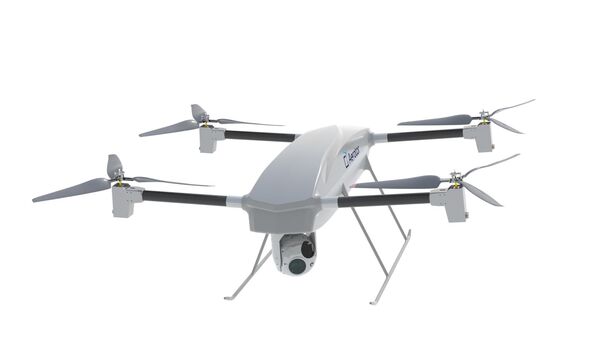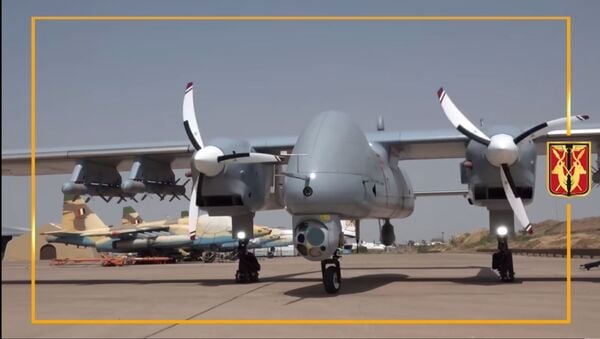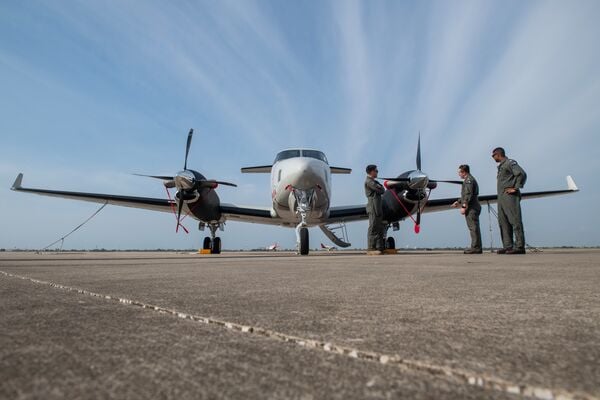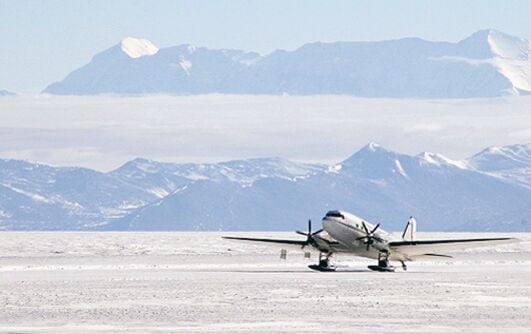- About
- Intara
- Capabilities
- Advisory
- Resources
- News
- Store
Israeli MoD looking at petrol-engine quadcopter UAVs to lift heavier loads
11 October 2022
by Yaakov Lappin


The Israeli company Aerotor is developing the Apus 50 unmanned quadcopter to carry a 30 kg payload. (Aerotor)
The Israel Ministry of Defense's Directorate of Defense Research & Development (DDR&D) and the Aerotor unmanned aerial vehicle (UAV) company are jointly developing a platform that appears to be a front runner for the future main air logistical system for the Israel Defense Forces (IDF).
Raz Geva, CEO and co-founder of Aerotor, told Janes that the two UAVs his company is developing, the Apus 15, which is already a functioning prototype, and the Apus 50, are based on a new technology that enables unprecedented flight endurance, payload, and speed.
In contrast to the usual multirotor UAVs that have electric motors for each rotor, enabling them to independently change their revolutions per minute (RPMs) for manoeuvres, the Apus concept uses a central petrol engine that powers four rotors that change their angle, not their RPM.
Chadian Air Force unveils Aksungur UAV
23 April 2024
by Jeremy Binnie


Chad's new Aksungur is seen warming up for take-off in a still from a video released by the AAT. (Armée de l'Air Tchadienne)
The Chadian Air Force (AAT) has revealed it has received at least one Turkish Aerospace (TUSAŞ) Aksungur unmanned aerial vehicle (UAV).
It released a video on 21 April that included footage of an Aksungur with AAT markings and the Turkish-format serial 23013 taking off from Adji Kosseï Air Base at N'Djamena International Airport armed with eight MAM-L small laser-guided bombs. The video also featured AAT personnel being trained by TUSAŞ in Türkiye.
The AAT operates at least two TUSAŞ Anka UAVs and three TUSAŞ Hürkuş-C turboprop light-attack aircraft, which were unveiled when President General Mahamat Idriss Déby Itno visited Adji Kosseï Air Base in July 2023.
US Navy accepts first two Textron T-54 deliveries
23 April 2024
by Zach Rosenberg


The first of two Textron T-54s delivered to the US Navy, intended to replace the T-44s. The deliveries were announced on 22 April. (US Navy)
US Naval Air Systems Command (NAVAIR) accepted delivery of the first two Textron T-54 Multi-Engine Training System (METS) aircraft at Naval Air Station (NAS) Corpus Christi, Texas, the service announced on 22 April. The aircraft are set to begin training students at NAS Corpus Christi's Training Air Wing Four in boreal spring 2025, the US Navy (USN) told Janes .
The USN intends to operate 64 of the Textron King Air 200-based aircraft, which will replace the Textron T-44 as the service's main twin-engine pilot training aircraft. Deliveries are set to run through 2026, and the aircraft is meant to operate until 2055.
“This aircraft brings modernised training to student naval aviators and prepares them for the advanced aircraft they will fly in the fleet,” said Captain Duane Whitmer, USN programme manager.
US Department of State approves Basler BT-67 sale to Argentina
23 April 2024
by Zach Rosenberg


The BT-67 is no stranger to Antarctica's harsh climate. This picture displays a Basler BT-67 (re-engined DC-3) in polar configuration equipped with snow skids. (Basler)
The US Department of State has approved Argentina's request to purchase Basler BT-67s, support equipment, and training for up to USD143 million, the department announced on 18 April.
“The proposed sale will … [provide] additional capacity for airdrop and airlift operations to service Antarctica during the winter season,” the announcement read. “This will reduce the burden on other airlift assets in Argentina.”
The number of aircraft to be purchased is unknown, but the deal includes spare engines, ground handling equipment, transport, and personnel training. Basler and the Argentine Ministry of Defense had not responded to Janes questions at the time of publication.
Argentina maintains nearly a dozen research bases on Antarctica, according to the country's Ministry of Foreign Affairs, International Trade and Worship. Argentina's air force operates several aircraft types capable of operating in Antarctica, including four Lockheed Martin C-130Hs and seven de Havilland DHC-6s.
The Israel Ministry of Defense's Directorate of Defense Research & Development (DDR&D) and the Aerot...
Latest Podcasts
Iran Israel analysis
In this podcast Janes analysts discuss the Iranian attacks on Israel on the 14 April. They highlight the military systems used by Iran and the performance and impact of these on Israel. They also discuss the implications of this attack goi...
Listen nowJanes Case Studies
Using Janes Intara to build a common intelligence picture: Russian build up on the Ukrainian border
View Case StudyNews Categories
 Air Details
Air Details